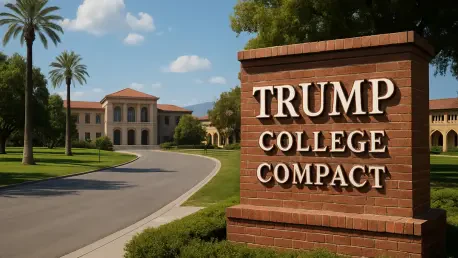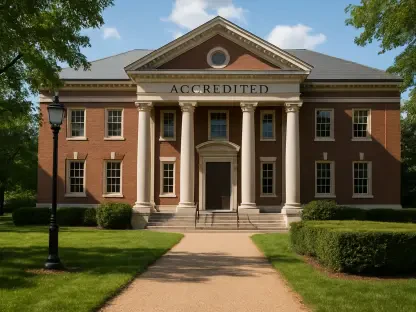Imagine a scenario where the federal government offers a lucrative deal to top universities, promising prioritized research funding but at a steep cost—surrendering control over admissions, protest policies, and ideological stances, which has become the harsh reality for select California institutions under the Trump administration’s proposed college compact. This has sparked a fierce battle with Governor Gavin Newsom. As state and federal powers collide over the future of higher education, this roundup gathers diverse opinions, critiques, and insights from various stakeholders in academia and policy circles. The purpose is to dissect the controversy, compare contrasting perspectives, and shed light on what this conflict means for universities, academic freedom, and the balance of power.
Exploring the Controversy: What’s at Stake with the College Compact?
Understanding the Compact’s Framework and Conditions
The Trump administration’s college compact targets nine prominent research universities, including one in California, with a deal that ties federal research grants to strict operational and ideological changes. Conditions include capping international student enrollment at 15%, enforcing institutional neutrality on non-campus issues, and banning diversity considerations in admissions outside specific exemptions for religious or single-sex schools. Higher education groups have expressed alarm over these mandates, viewing them as a direct challenge to university autonomy.
Critics from academic associations argue that such conditions undermine the core mission of fostering open inquiry. Many point out that imposing caps on international students could stifle global collaboration, a cornerstone of cutting-edge research. Meanwhile, defenders of the compact within certain policy circles suggest that these measures aim to refocus universities on national priorities, though this view struggles to gain traction among most educators.
The debate over autonomy versus federal influence remains heated. While some policy analysts see the compact as a legitimate tool to enforce accountability, a larger chorus of voices in higher education warns that it sets a dangerous precedent. The fear is that accepting these terms could erode the independence that allows universities to innovate and challenge societal norms.
Federal Funding: A Tool for Reform or a Form of Control?
At the heart of the compact lies the use of federal funding as leverage, a shift from past punitive approaches to a more incentivized strategy. Universities that comply gain prioritized access to grants, a tempting offer for research-heavy institutions facing budget constraints. However, numerous academic leaders describe this as coercion masked as opportunity, likening it to a patronage system where loyalty trumps merit.
The financial stakes are particularly high in California, where state support is substantial. Critics highlight the risk for institutions like those in the University of California system, which could lose billions in state funding under Newsom’s threat if they sign the compact. This creates a dilemmalign with federal incentives and risk state backlash, or reject the deal and potentially miss out on critical research dollars.
Perspectives on this tactic vary widely. Some fiscal policy experts argue that federal funding should come with strings attached to ensure alignment with broader national goals. In contrast, many university administrators contend that such dependencies threaten their ability to prioritize academic excellence over political agendas, raising questions about the long-term impact on innovation.
Diverse Reactions: From State Resistance to Institutional Dilemmas
Newsom’s Defiant Response and California’s Academic Values
Governor Gavin Newsom has taken a hardline stance against the compact, threatening to cut state funding and access to Cal Grants for any California institution that agrees to the federal terms. His administration frames this as a necessary defense against what it calls radical conservative ideological impositions. This position resonates with many in the state’s higher education community, who see it as a stand for academic integrity.
This resistance is not isolated but part of a broader pattern of state-federal tensions in California. Policy observers note that Newsom’s approach mirrors past confrontations over issues like federal deployments in state matters, underscoring a consistent pushback against perceived overreach. The governor’s bold move has sparked discussions about whether other states might adopt similar protective measures for their universities.
Academic advocates applaud this stance, arguing that state intervention is crucial to counterbalance federal pressures. However, some fiscal conservatives caution that such threats could strain university budgets further if federal funds are lost without viable alternatives. This split in opinion highlights the complex interplay of ideology and economics in shaping responses to the compact.
Varied Institutional Perspectives: Resistance or Compliance?
While California’s universities largely align with Newsom’s rejection of the compact, not all institutions nationwide share this view. For instance, representatives from a major university in Texas have signaled openness to engaging with the proposal, citing potential financial benefits. This divergence illustrates how regional political climates can influence institutional decisions, creating a patchwork of responses.
Many California-based faculty and student groups vehemently oppose the compact, emphasizing its threat to diversity and free expression. They argue that mandates like protest restrictions could chill campus activism, a vital component of university culture. This perspective dominates in progressive-leaning states, where the compact is often seen as an ideological assault rather than a reform effort.
On the other hand, a minority of voices from more conservative academic circles suggest that the compact addresses real issues, such as perceived biases in curriculum or hiring. Though outnumbered, these opinions reveal a nuanced debate within academia itself, where the question of whether universities need external correction or protection from interference remains unresolved.
Ideological Divides and Broader Implications
Is the Compact a Conservative Push or a Needed Overhaul?
The compact’s conditions, including requirements for ideological assessments of staff and students, have led many to view it as a conservative agenda targeting perceived liberal dominance in academia. Critics from national education organizations argue that such measures prioritize partisan goals over educational quality, potentially alienating diverse talent and ideas.
Supporters of the compact, often from right-leaning think tanks, counter that universities have drifted too far from neutrality, necessitating intervention to restore balance. They point to instances of protest policies or departmental biases as evidence of a need for reform. This viewpoint, though less prevalent, adds a layer of complexity to the narrative surrounding the compact’s intent.
The ideological rift extends beyond policy into the classroom, with concerns about how such mandates could reshape academic discourse. Many educators worry that fear of non-compliance might suppress critical discussions, while others question whether the compact overreaches by assuming uniform progressivism across all institutions. This tension underscores a deeper struggle over who defines the purpose of higher education.
Strategies and Solutions for Navigating the Conflict
Amid this standoff, universities face the challenge of preserving autonomy while managing financial realities. Some higher education strategists recommend forming coalitions to collectively resist federal pressures, pooling resources to lessen dependency on any single funding source. This approach could offer a buffer against both state and federal ultimatums.
Others suggest seeking alternative funding through private partnerships or alumni networks to reduce reliance on government grants. While not a complete solution, this tactic might provide breathing room for institutions caught in the crossfire. The idea has gained traction among smaller colleges, though scalability for larger research universities remains uncertain.
Additionally, advocacy groups urge campuses to engage stakeholders—students, faculty, and communities—in transparent discussions about the compact’s implications. Building public support could amplify their voice in policy debates, ensuring that decisions reflect the broader academic mission rather than short-term fiscal gains. This grassroots strategy is seen as vital for long-term resilience.
Reflecting on the Debate and Moving Forward
Looking back, the clash between Governor Newsom and the Trump administration over the college compact revealed profound divisions over the role of government in higher education. Voices from across academia, policy spheres, and state leadership exposed a spectrum of concerns, from threats to academic freedom to financial survival. The contrasting responses, particularly California’s defiance versus Texas’s receptiveness, underscored how deeply ideology and regional dynamics shaped the discourse.
Moving forward, stakeholders should prioritize collaborative efforts to protect university independence, such as establishing bipartisan task forces to mediate between state and federal interests. Exploring innovative funding models beyond government support could also empower institutions to stand firm on their values. For those eager to delve deeper, tracking policy developments through higher education associations or state legislative updates offers a pathway to stay informed and engaged in shaping the future of academia.









